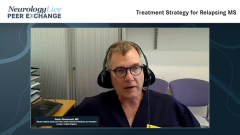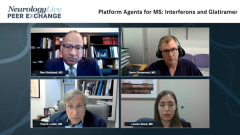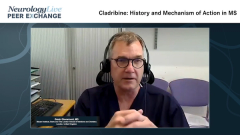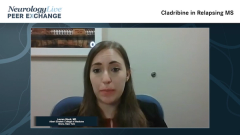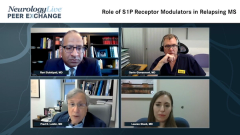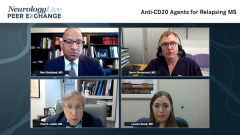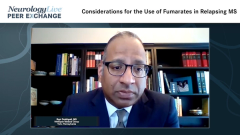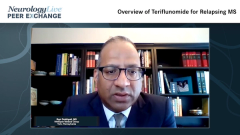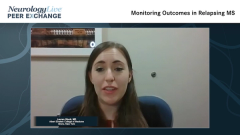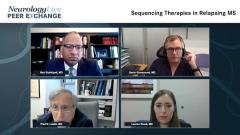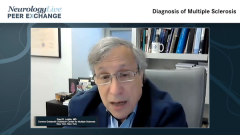
Sequencing Therapies in Relapsing MS
Experts in multiple sclerosis (MS) discuss key factors involved in the sequencing of therapies for relapsing MS.
Episodes in this series

Fred D. Lublin, MD: Gavin, take us through sequencing. We have all these agents, and we talked about the various agents. What do we do next?
Gavin Giovannoni, MD: I don’t think there’s any reason why you can’t sequence in any order, so I don’t think starting DMT [disease-modifying therapy] X precludes any other DMT, and vice versa. All you have to do is apply the baseline screening for those DMTs, so sequencing can be driven by tolerance issues or adverse events, be it liver function tests, but that’s a different story to efficacy sequencing. There are different types of efficacy sequencing. There’s upward or downward efficiency sequencing. The reason I say that is, obviously, if you have breakthrough activity and the drug has failed you, you need to move up.
I tend to not move sideways, but to move up in efficacy class, so we go from say the platforms to the intermediate to the high- efficacy treatments. What I find difficult is when you’re at the top end and you’ve gotten breakthrough activity, where do you go? My threshold for shifting there is a little higher, simply because of the question, where do you go? Obviously, for the derisking strategy, let’s give the typical example of PML [progressive multifocal leukoencephalopathy] risk on natalizumab. We would do sequencing there to derisk the patient, in other words, we would try to lower the risk of PML. That is a whole story of its own; how do you derisk a patient? How do you switch from natalizumab to prevent rebound? Which agents do you go to? We have quite a big protocol. We’ve almost completely shifted to anti-CD20 monoclonal antibodies post-natalizumab. We used to go to fingolimod, but now we’re going to ocrelizumab in almost all of our patients. I’ve had a few patients where we’ve moved on to cladribine, and even a few on to alemtuzumab.
You have to be extremely careful when you move to a depleter agent because if you get carry-over PML, then you have a problem because the patients are immunosuppressed by the depletion cycle, and they need their immune systems to recover from PML. We have a very strict protocol to make sure there isn’t any PML, or asymptomatic PML, before switching medications. But Fred, you wanted me to summarize. I think the other message people need to appreciate is that you have to have a lot of detailed information and knowledge about each DMT when you do sequencing because some of the issues around specific sequencing, let’s give you an example. Moving from fingolimod to cladribine, for example, you have to wash a drug out, and not everybody reconstitutes their lymphocyte counts quickly enough.
We, in our center ,Blizard Institute, Barts and The London School of Medicine and Dentistry, measure the lymphocyte counts weekly, and when they get above 800 per μL, we dose the patient with cladribine. The reason we don’t want to wait until they get above 1 1000/μL, which is on the label, is because you go into that period where you get rebound. You don’t want to have them uncovered, so this is why the issues around sequencing are quite complex and not easy to get across in a 2-minute or 3-minute discussion. I don’t know if Ravi or Lauren have any comments about specific sequencing.
Fred D. Lublin, MD: So, the mechanism of action counts
Gavin Giovannoni, MD: Oh yes, definitely.
Fred D. Lublin, MD: This is important. Ravi?
Ravi Dukkipati, MD: I don’t have anything to add. I think mechanism of action is very important and needs to be taken into account with the considerations of sequencing.
Fred D. Lublin, MD: We’ve had a concern about anti-CD20s and S1Ps [sphingosine-1-phosphate receptors] as well, at least the longer-acting ones, as to whether we might miss the B cells that are sequestered. In practice, we haven’t seen it, checking B-cell counts moving forward, but it is something that needs to be explored more carefully when you switch from one to the other. But one of the other issues that I personally have is that we don’t have good data to define inadequate response. Our goal, our aspiration for any therapy, is neither—no activity whatsoever, no relapses—nothing new in the MRI. It’s a nice aspiration to have, but it’s not the reality of any of our agents, at least early on. How much activity is acceptable and how much says, “No, you need to switch?” At what time point? For example, we do a baseline MRI on all of our patients when we start them on therapy at 3 months. Some people prefer 6 months, but we give the drug at least 3 months to kick in because, I think, that holds for almost all of the agents. We use that moving forward, but even when you move forward, is 1 new MRI lesion per year a reason to switch, or 2? If it were 10, you probably would, but where do you slice it? Thoughts?
Ravi Dukkipati, MD: Yes, that’s a very good point, Dr Lublin, and I think clinical trials have rigidly defined parameters, but real-world practices are just that. How many lesions are too many, and how many new symptoms are too many? I think we have to find the balance between switching too prematurely vs waiting too long. To follow up on what Dr Gluck mentioned earlier, in addition to required laboratory monitoring, we see our patients 2 to 3 times per year for follow-up, and more often if they’re having active symptoms. Imaging is a fluid thing in real practice. We image, on average, every year, but sometimes we’ll go longer if a patient is doing well. But we emphasize the importance of periodic surveillance imaging to screen for breakthrough radiographic activity.
Gavin Giovannoni, MD: Fred, one of the things we’re seeing now, and you must have the same issue, is that you have people who have been stable, without relapses or MRI activity, for several years on fingolimod or any DMT, and then they start coming to you with worsening disability. I would call this a delayed, smoldering component of the disease. But I’m not sure if the drug is failing those people because it’s keeping the relapses and the focal MRI activity away. What’s driving that worsening is probably the processes that our therapies aren’t targeting, and I feel very uncomfortable switching those patients to other anti-inflammatory DMTs because I don’t think it makes a difference in those patients. I don’t know what your opinion is about those. My clinic is now full of these patients who I call, “NEIDA”—no evidence of inflammatory disease activity—but they are getting worse.
Fred D. Lublin, MD: Yes, this is a new issue. It’s brought up by this concept of progression independent of relapse activity, which is secondary progressive MS [multiple sclerosis], and how best to deal with that.
Thank you all for watching this NeurologyLive® Peer Exchange. If you enjoyed the content, please subscribe to our e-newsletters to receive upcoming Peer Exchanges and other great content right in your inbox. Thank you for joining us.
Transcript Edited for Clarity
Newsletter
Keep your finger on the pulse of neurology—subscribe to NeurologyLive for expert interviews, new data, and breakthrough treatment updates.

